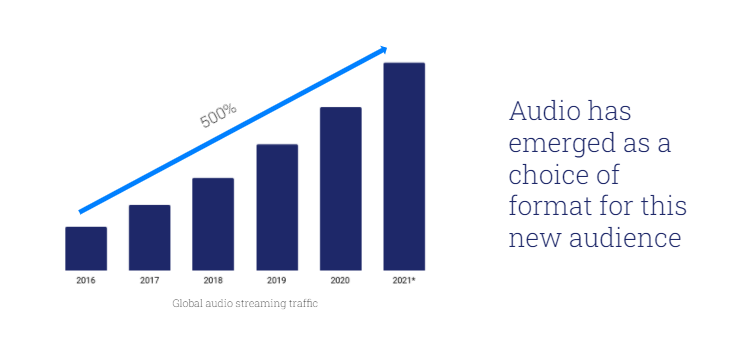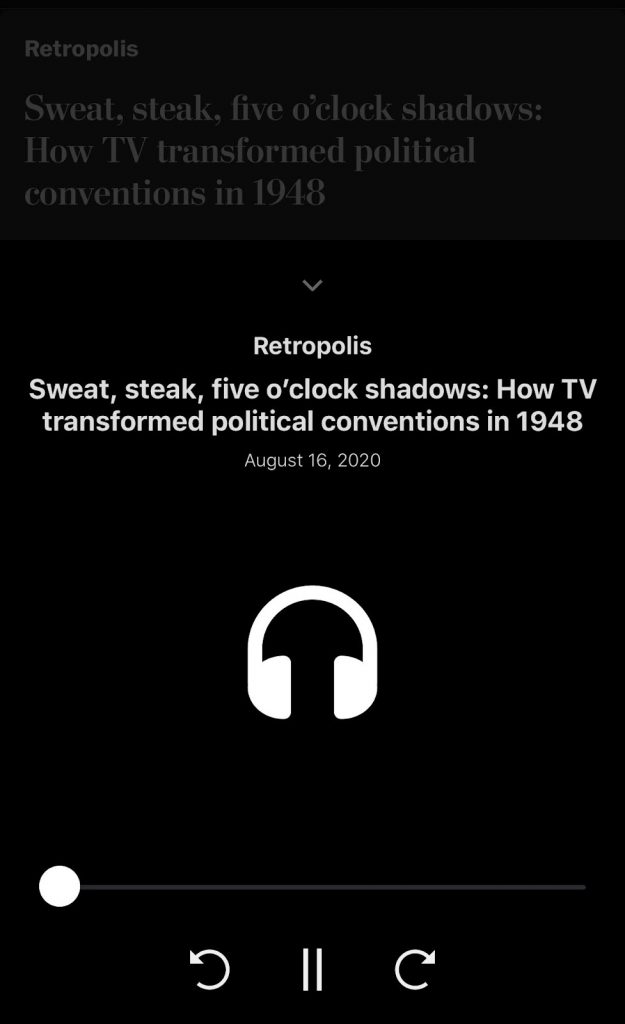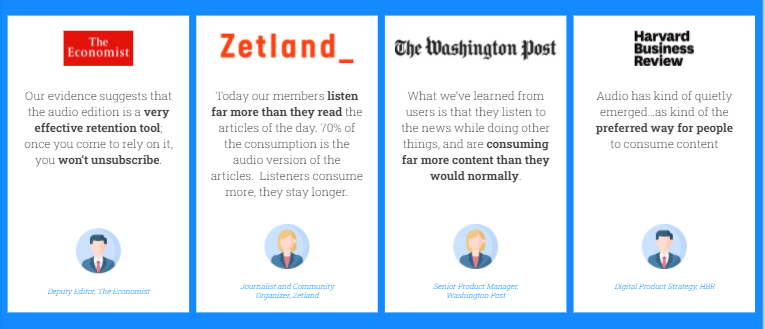Emily Chow, Director of Site Product at The Washington Post, said, “We conducted user research and learned that users want to stay informed but are busy, so they appreciate an option to get up to speed on the latest news developments while cooking dinner, running errands or exercising.”
The audio was certainly in demand. To offer the best experience to the users, publishers started integrating podcasts into their strategy, which turned out to be a big success to many. The New York times succeeded with “The daily“. Other publishers like Les Echos in France and BBC in the U.K. also have specific audio editions for Google Home or Amazon Alexa. The rising popularity of podcasts inspired many publishers to increase their audio offerings to their audience.
What Does the Audio Edition Mean for Publishers?
A few years back, podcasts were introduced, and many media companies grabbed the opportunity. And so we have witnessed The daily, Apple news today, BBC, and so many more. Podcasts and smart speakers have become crowded, and audio articles have become an exciting opportunity because of less competition.
Spoken word’s of audio listening has increased 30% in the US over the last six years & 8% in the last year. Two-thirds of podcast listeners now prefer it over reading. It’s more convenient for them as it allows them to multitask. In fact, according to Nielsen Q1 2018 Podcast Insights, 49% of people in the US listen to podcasts at home, while 22% do it while driving.

Audio edition is audio articles. Publishers can enter this audio space without making any heavy investment by reading aloud the already written journalism. Audio articles are easy to produce compared to podcasts or smart speaker briefings, which have high production value.
How Can You Retain Users and Gain a Loyal Audience?
“Our evidence suggests that the audio edition is a very effective retention tool; once you come to rely on it, you won’t unsubscribe,” says Tom Standage, Deputy Editor, The Economist.
Before the pandemic, publishers were investing in audio. One most prominent example is The Economist. They have been offering an audio edition since 2007, and they still continue to do it because it leaves a significant impact on retention.
The Washington Post had also planned to begin audio articles for commuters. But when work from home became a pattern, a concern appeared about the usage of audio articles. Nevertheless, according to a research, the audience was able to catch up with the Washington post’s journalism while running their daily errands. Even while the work from home continued, there was steady adoption of audio news. The Washington Post recently made audio format available for all its articles in Android and iOS.

In 2016, a Danish digital magazine, Zetland, was all set to launch its daily news. When the team at Zetland asked their supporters what they were expecting from the publication, one thing kept coming up, audio. It was crowdfunded, and Zetland didn’t raise money for audio development. The cofounder Akon Mosbech said, “We all come from a text background. We just thought the text would be the ideal medium to convey what we wanted to do.”
But after months of readers requests, the first audio article went live, and people listened. Today in Denmark, Zetland is a success with audio articles. They have offered all articles in audio forms since 2017. The audio edition worked so well for Zetland that they gained 2000 new members during the lockdown.
Audio articles are different from podcasts as they do not offer dramatic audio or storytelling but offer what is convenient for the listeners. Mosbech doesn’t recognise the audio articles as a replacement for podcasts or text. Instead, he believes audio articles complement both platforms and give the audience what they want. Also, Zetland has recognised that the listening audience is a loyal audience.
Before the audio implementation, members said they didn’t read enough content to take a subscription. But with audio, they use Zetland more, making the average completion rate for an audio story at 90%.
Zetland is just one example. The Economist, The New Yorker, Harvard Business Review, The Atlantic are also some magazines offering audio articles and seeing a significant increase in user retention.

How to Add Audio to Your Articles?
Surprisingly! In the entire process of the audio edition, adding audio turns out to be the simplest part. Initially, when publishers created audio articles, they hired freelancers to do the narration or the journalists both wrote and read the articles aloud. But this is not what happens nowadays.
When audio articles started becoming popular in the news industry, some businesses created solutions for audio conversion. Publishers still preferred in-house narration as these voices turned out robotic with no feelings and less regard for the abbreviations.
But things are different now. There are lifelike voices available with emotions and sentiments, and pauses. The experts accept these human-like voices as they narrate the news to the audience and sound like a real person is reading it. The audience connects and listens more and more.
One excellent way of adding audio to your articles is using the Listen2It audio player. It’s a simple one-time integration, and all your articles will convert to audio. There are 600+ lifelike voices in 75 different languages at Listen2It. There’s an audio player at the top of this article. Go ahead and give it a try. If you wish to add audio to your articles, sign up with Listen2It or get in touch with us. We would love to get on a call and give a demo.
Reading and listening should both be available to your audience as they might consume content anywhere. So why restrict them to just reading?

Leave a Reply